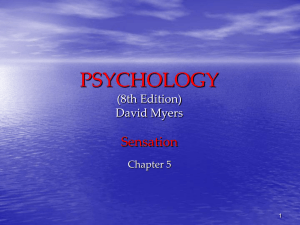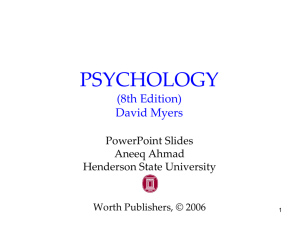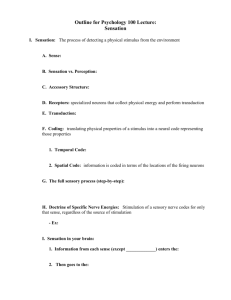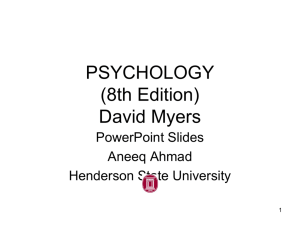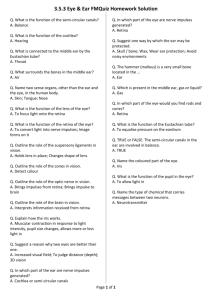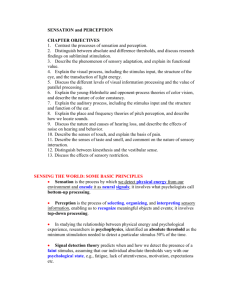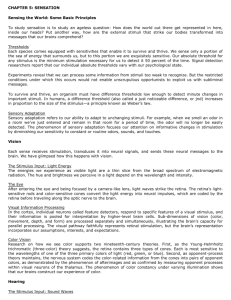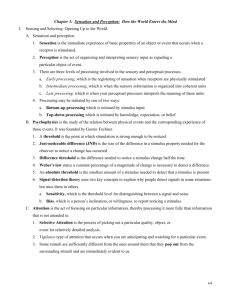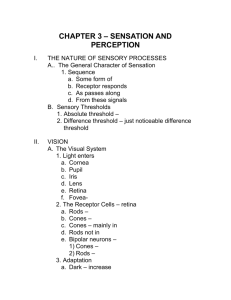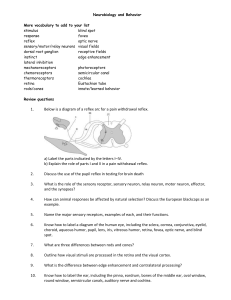Sensation & Perception
advertisement
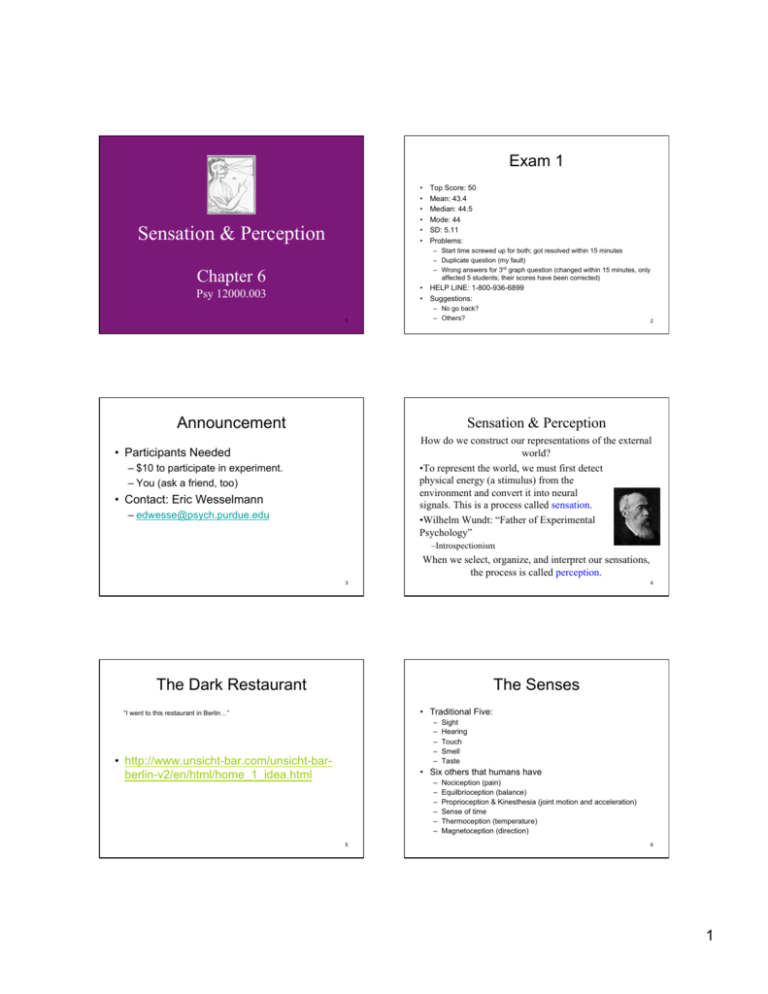
Exam 1 • • • • • • Sensation & Perception Top Score: 50 Mean: 43.4 Median: 44.5 Mode: 44 SD: 5.11 Problems: – Start time screwed up for both; got resolved within 15 minutes – Duplicate question (my fault) – Wrong answers for 3rd graph question (changed within 15 minutes, only affected 5 students; their scores have been corrected) Chapter 6 • HELP LINE: 1-800-936-6899 • Suggestions: Psy 12000.003 1 – No go back? – Others? Announcement 2 Sensation & Perception How do we construct our representations of the external world? • To represent the world, we must first detect physical energy (a stimulus) from the environment and convert it into neural signals. This is a process called sensation. • Wilhelm Wundt: “Father of Experimental Psychology” • Participants Needed – $10 to participate in experiment. – You (ask a friend, too) • Contact: Eric Wesselmann – edwesse@psych.purdue.edu – Introspectionism When we select, organize, and interpret our sensations, the process is called perception. 3 4 The Dark Restaurant The Senses • Traditional Five: “I went to this restaurant in Berlin…” – – – – – • http://www.unsicht-bar.com/unsicht-barberlin-v2/en/html/home_1_idea.html Sight Hearing Touch Smell Taste • Six others that humans have – – – – – – 5 Nociception (pain) Equilbrioception (balance) Proprioception & Kinesthesia (joint motion and acceleration) Sense of time Thermoception (temperature) Magnetoception (direction) 6 1 Bottom-up Processing Top-Down Processing Analysis of the stimulus begins with the sense receptors and works up to the level of the brain and mind. Information processing guided by higher-level mental processes as we construct perceptions, drawing on our experience and expectations. THE CHT Letter “A” is really a black blotch broken down into features by the brain that we perceive as an “A.” 7 8 Top-Down or Bottom-Up? Making Sense of Complexity Our sensory and perceptual processes work together to help us sort out complex images. Learned depth cues make this a top down perceptual distortion 9 “The Forest Has Eyes,” Bev Doolittle Sensing the World 10 Exploring the Senses Senses suit an organism’s needs, enabling survival. What stimuli cross our threshold for conscious awareness? A frog feeds on flying insects so visual acuity must be very sensitive; a male silkworm moth is sensitive to female sex-attractant odor; and we as human beings are sensitive to sound frequencies that represent the range of human voice. Could we be influenced by stimuli too weak (subliminal) to be perceived? Why are we unaware of unchanging stimuli, like a band-aid on our skin? 11 12 2 22nd October 1850 Psychophysics A study of the relationship between physical characteristics of stimuli and our psychological experience with them. Physical World Psychological World Light Brightness Sound Volume Pressure Weight Sugar Sweet A relative increase in mental intensity, Fechner realized, might be measured in terms of the relative increase in physical energy required to bring it about. Gustav Fechner (1801-1887) 13 14 Detection Thresholds Absolute Threshold: Minimum stimulation needed for an individual to detect a particular stimulus 50% of the time. Proportion of “Yes” Responses 0.00 0.50 1.00 Absolute Threshold Intensity No No No Yes Yes Observer’s Response Detected Tell when you (the observer) detect the light. 15 Subliminal Threshold 0 5 10 15 20 Stimulus Intensity (lumens) 25 16 Difference Threshold Subliminal Threshold: When stimuli are below one’s absolute threshold for conscious awareness. Difference Threshold: Minimum difference between two stimuli required for detection 50% of the time, also called just noticeable difference (JND). Difference Threshold Kurt Scholz/ Superstock No No Yes Observer’s Response 17 Tell when you (observer) detect a difference in the light. 18 3 Weber’s Law Signal Detection Theory (SDT) Two stimuli must differ by a constant minimum percentage (rather than a constant amount), to be perceived as different. Weber fraction: k = δI/I. Constant (k) Light 8% Weight 2% Tone 3% Person’s experience Expectations Motivation Level of fatigue Carol Lee/ Tony Stone Images Stimulus Predicts how and when we detect the presence of a faint stimulus (signal) amid background noise (other stimulation). SDT assumes that there is no single absolute threshold and detection depends on: 19 20 SDT Matrix Sensory Adaptation The observer decides whether she hears the tone or not, based on the signal being present or not. This translates into four outcomes. Diminished sensitivity as a consequence of constant stimulation. Decision Yes No Present Hit Miss Absent False Alarm Correct Rejection Signal 21 Put a band aid on your arm and after awhile you don’t sense it. 22 Sensation without Perception Now you see, now you don’t Video on Visual Prosopagnosia 23 24 4 Skin Senses The sense of touch is a mix of four distinct skin senses —pressure, cold, warmth, and pain. Only pressure has identifiable receptors. All other skin sensations are variations of pressure, warmth, cold and pain. Bruce Ayers/ Stone/ Getty Images Sense of Touch Pressure 25 Vibration Vibration Cold, warmth and pain Burning hot Touch Sensation/Perception 26 Taste • The intense tickling sensation that makes you laugh uncontrollably… Traditionally, taste sensations consisted of sweet, salty, sour, and bitter tastes. Recently, receptors for a fifth taste have been discovered called “Umami”. – Only happens when someone else tickles you – You cannot tickle yourself and get this response (Blakemore, et al., Sweet 2000) Sour Salty Bitter • Why? 27 Umami (Fresh Chicken) 28 Sensory Interaction When one sense affects another sense, sensory interaction takes place. So, the taste of strawberry interacts with its smell and its texture on the tongue to produce flavor. Taste Scientific American Frontiers: Tasters and Super-tasters 29 30 5 Smell Age, Gender, and Smell Like taste, smell is a chemical sense. Odorants enter the nasal cavity to stimulate 5 million receptors to sense smell. Unlike taste, there are many different forms of smell. Ability to identify smell peaks during early adulthood, but steadily declines after that. Women are better at detecting odors than men. 31 32 Example of Sensory Interaction Audition/Vision Smell and Memories The brain region for smell (in red) is closely connected with the brain regions involved with memory (limbic system). That is why strong memories are made through the sense of smell. Count the Fs: FINISHED FILES ARE THE RESULTS OF YEARS OF SCIENTIFIC STUDY COMBINED WITH THE EXPERIENCE OF YEARS. 33 34 Pheromones, Odor, and Sweaty T-Shirts • http://www.pbs.org/wgbh/evolution/library/ 01/6/l_016_08.html • Adaptive to prefer mate with different immune system to one’s own: MHC Vision (major histocompatibility locus) • Women preferred the scents of T-shirts worn by men whose MHC genes were different from their own. 35 36 6 Transduction The Stimulus Input: Light Energy In sensation, the transformation of stimulus energy into neural impulses. Phototransduction: Conversion of light energy into neural impulses that the brain can understand. Both Photos: Thomas Eisner Visible Spectrum 37 Light Characteristics 38 Wavelength (Hue) Hue (color) is the dimension of color determined by the wavelength of the light. Wavelength (hue/color) Intensity (brightness) Saturation (purity) Wavelength is the distance from the peak of one wave to the peak of the next. 39 Wavelength (Hue) Violet Indigo 400 nm Short wavelengths Blue Green Yellow Orange 40 Intensity (Brightness) Intensity Amount of energy in a wave determined by the amplitude. It is related to perceived brightness. Red 700 nm Long wavelengths Different wavelengths of light result in different colors. 41 42 7 Intensity (Brightness) Purity (Saturation) Saturated Saturated Blue color with varying levels of intensity. As intensity increases or decreases, blue color looks more “washed out” or “darkened.” Monochromatic light added to green and red makes them less saturated. 43 Color Solid 44 The Eye Represents all three characteristics of light stimulus on this model. http://www.visionconnection.org 45 Parts of the eye 46 The Lens Lens: Transparent structure behind the pupil that changes shape to focus images on the retina. 1. Cornea: Transparent tissue where light enters the eye. 2. Iris: Muscle that expands and contracts to change the size of the opening (pupil) for light. 3. Lens: Focuses the light rays on the retina. 4. Retina: Contains sensory receptors that process visual information and sends it to the brain. Accommodation: The process by which the eye’s lens changes shape to help focus near or far objects on the retina. 47 48 8 The Lens Retina Nearsightedness: A condition in which nearby objects are seen more clearly than distant objects. Retina: The lightsensitive inner surface of the eye, containing receptor rods and cones in addition to layers of other neurons (bipolar, ganglion cells) that process visual information. Farsightedness: A condition in which faraway objects are seen more clearly than near objects. 49 Optic Nerve, Blind Spot & Fovea Test your Blind Spot Optic nerve: Carries neural impulses from the eye to the brain. Blind Spot: Point where the optic nerve leaves the eye because there are no receptor cells located there. This creates a blind spot. Fovea: Central point in the retina around which the eye’s cones cluster. http://www.bergen.org 50 Use your textbook. Close your left eye, and fixate your right eye on the black dot. Move the page towards your eye and away from your eye. At some point the car on the right will disappear due to a blind spot. 51 Photoreceptors 52 Bipolar & Ganglion Cells Bipolar cells receive messages from photoreceptors and transmit them to ganglion cells, which are for the optic nerve. E.R. Lewis, Y.Y. Zeevi, F.S Werblin, 1969 53 54 9 Visual Information Processing Ganglion & Thalamic Cells Optic nerves connect to the thalamus in the middle of the brain, and the thalamus connects to the visual cortex. Retinal ganglion cells and thalamic neurons break down visual stimuli into small components and have receptive fields with center-surround organization. ON-center OFF-Surround Action Potentials 55 56 Shape Detection Nerve cells in the visual cortex respond to specific features, such as edges, angles, and movement. Specific combinations of temporal lobe activity occur as people look at shoes, faces, chairs and houses. Ross Kinnaird/ Allsport/ Getty Images Ishai, Ungerleider, Martin and Haxby/ NIMH Feature Detection 57 Theories of Color Vision 58 Subtraction of Colors Trichromatic theory: Based on behavioral experiments, Helmholtz suggested that the retina should contain three receptors that are sensitive to red, blue and green colors. Standard stimulus Comparison stimulus Max Medium Low Blue Green Red 59 If three primary colors (pigments) are mixed, subtraction of all wavelengths occurs and the color black is the result. 60 10 Addition of Colors Photoreceptors: Trichromatic Theory If three primary colors (lights) are mixed, the wavelengths are added and the color white is the result. Fritz Goro, LIFE magazine, © 1971 Time Warner, Inc. Blue Cones Green Cones Short wave Medium wave Red Cones MacNichol, Wald and Brown (1967) measured directly the absorption spectra of visual pigments of single cones obtained from the retinas of humans. 61 Long wave 62 Opponent Process Theory Color Blindness Hering proposed that we process four primary colors combined in pairs of red-green, blue-yellow, and black-white. Genetic disorder in which people are blind to green or red colors. This supports the Trichromatic theory. Cones Retinal Ganglion Cells 63 Opponent Colors Ishihara Test 64 Perception in Brain Our perceptions are a combination of sensory (bottom-up) and cognitive (top-down) processes. Gaze at the middle of the flag for about 30 Seconds. When it disappears, stare at the dot and report whether or not you see Britain's flag. 65 66 11 Visual Information Processing From Sensation to Recognition 67 Tim Bieber/ The Image Bank Processing of several aspects of the stimulus simultaneously is called parallel processing. The brain divides a visual scene into subdivisions such as color, depth, form and movement etc. 68 Change Blindness Color Constancy • Phenomenon that occurs when a person viewing a visual scene apparently fails to detect large changes in the scene. • The change typically has to coincide with some visual disruption (saccade: eye movement) or a brief obscuration of the observed scene or image. • Memory (short term) may be involved. Color of an object remains the same under different illuminations. However, when context changes the color of an object may look different. R. Beau Lotto at University College, London http://www.youtube.com/watch?v=0grANlx7y2E 69 McConkie & Currie (1996) http://nivea.psycho.univ-paris5.fr/ECS/ECS-CB.html 70 Visual Illusions • http://www.michaelbach.de/ot/ Audition More on this in next lecture…. 71 72 12 The Stimulus Input: Sound Waves Sound Characteristics Sound waves are composed of compression (more dense) and rarefaction (less dense) of air molecules. Physical (psychological) Frequency (pitch) Intensity (loudness) Quality (timbre) Acoustical transduction: Conversion of sound waves into neural impulses in the hair cells of the inner ear. 73 Frequency (Pitch) 74 Intensity (Loudness) Frequency (pitch): The dimension of frequency determined by the wavelength of sound. Intensity (Loudness): Amount of energy in a wave, determined by the amplitude, relates to the perceived loudness. Wavelength: The distance from the peak of one wave to the peak of the next. 75 76 Loudness of Sound Quality (Timbre) 120dB 70dB 77 http://www.1christian.net www.jamesjonesinstruments.com Richard Kaylin/ Stone/ Getty Images Quality (Timbre): Characteristics of sound from a zither and a guitar allows the ear to distinguish between the two. Zither 78 Guitar 13 Overtones The Ear Dr. Fred Hossler/ Visuals Unlimited Overtones: Makes the distinction among musical instruments possible. 79 80 The Ear Cochlea Outer Ear: Pinna. Collects sounds. Cochlea: Coiled, bony, fluid-filled tube in the inner ear that transforms sound vibrations to auditory signals. Middle Ear: Chamber between eardrum and cochlea containing three tiny bones (hammer, anvil, stirrup) that concentrate the vibrations of the eardrum on the cochlea’s oval window. Inner Ear: Innermost part of the ear, containing the cochlea, semicircular canals, and vestibular sacs. 81 82 Theories of Audition Theories of Audition Place Theory suggests that sound frequencies stimulate the basilar membrane at specific places resulting in perceived pitch. Frequency Theory states that the rate of nerve impulses traveling up the auditory nerve matches the frequency of a tone, thus enabling us to sense its pitch. Can not explain low frequencies http://www.pc.rhul.ac.uk Sound Frequency Auditory Nerve Action Potentials 100 Hz 200 Can not explain high frequencies 83 84 14 Localization of Sounds Localization of Sound Because we have two ears, sounds that reach one ear faster than the other ear cause us to localize the sound. 1. Intensity differences 2. Time differences Time differences as small as 1/100,000 of a second can cause us to localize sound. The head acts as a “shadow” or partial sound barrier. 85 86 Hearing Loss Hearing Deficits Conduction Hearing Loss: Hearing loss caused by damage to the mechanical system that conducts sound waves to the cochlea. Older people tend to hear low frequencies well but suffer hearing loss when listening for high frequencies. Sensorineural Hearing Loss: Hearing loss caused by damage to the cochlea’s receptor cells or to the auditory nerve, also called nerve deafness. 87 88 Deaf Culture Cochlear implants are electronic devices that enable the brain to hear sounds. Wolfgang Gstottner. (2004) American Scientist, Vol. 92, Number 5. (p. 437) EG Images/ J.S. Wilson © 89 Deaf Musician Cochlear Implant 90 15 Pain Pain tells the body that something has gone wrong. Usually pain results from damage to the skin and other tissues. A rare disease exists in which the afflicted person feels no pain. (CIPA: Congenital Insensitivity to Pain) PAIN AP Photo/ Stephen Morton 91 Biopsychosocial Influences Ashley Blocker (right) feels neither pain nor extreme hot or cold. 92 Gate-Control Theory Melzak and Wall (1965, 1983) proposed that our spinal cord contains neurological “gates” that either block pain or allow it to be sensed. Gary Comer/ PhototakeUSA.com 93 94 Pain Control Body Position and Movement Pain can be controlled by a number of therapies including, drugs, surgery, acupuncture, exercise, hypnosis, and even thought distraction. The sense of our body parts’ position and movement is called kinesthesis. The vestibular sense monitors the head (and body’s) position. Whirling Dervishes Bob Daemmrich/ The Image Works http://www.heyokamagazine.com Todd Richards and Aric Vills, U.W. ©Hunter Hoffman, www.vrpain.com 95 Wire Walk 96 16
